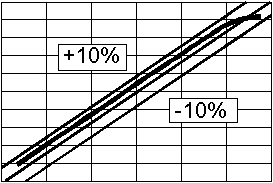Voltage controlled crystal oscillators typically employ a varactor diode to vary the frequency of oscillation by application of a tuning voltage. Tuning ranges vary from a fraction of a ppm to hundreds of ppm. Design considerations include tuning linearity, tuning bandwidth, tuning range, output level stability over tuning, post-tuning drift, phase noise, and stability.
- Linearity is usually specified as a percentage of the total tuning deviation from a straight line fit to the tuning curve. A 10% linearity specification would allow a deviation of 100 Hz away from the best straight line fit for an oscillator with a 1 kHz tuning range. The potential problem is that this deviation can occur rapidly at one end of the range as shown below. The slope is significantly lower at the top of the curve despite the fact that the oscillator meets a fairly tight linearity specification. For PLL systems where the tuning slope impacts the loop stability, it may be appropriate to specify the minimum and maximum tuning slope at all points on the curve in addition to the percent linearity.

- Tuning bandwidth is primarily set by the circuitry connecting the tuning voltage to the varactor. A high tuning bandwidth is usually easy to accomplish but beware of substantial phase shift caused by sudden roll-off. Try to specify a bandwidth about three to ten times higher than required by the PLL. Alternately, specify the roll-off characteristic for an additional decade.
- The tuning range should be kept as low as possible to reduce the oscillator’s susceptibility to noise on the tuning line. Remember to make allowances for temperature drift and long-term aging combined.
- It is common for wide-pull VCXOs to change output level over tuning by a few dB. Make sure to specify the output level stability if it is important.
- Post-tuning drift is relatively minor in VCXOs but it is not zero. A small amount of drift may be seen after tuning as the crystal and varactor reach a new thermal equilibrium.
- Phase noise and stability are usually degraded by the circuit modifications necessary to achieve large tuning ranges and the tuning voltage must be low noise.
Calculating the effects of tuning port noise on oscillator phase noise:
The spectral density, Sy(f), of the phase noise of an oscillator due to noise on the input is simply calculated by squaring the product of the tuning sensitivity and the voltage noise density. For example, consider a 10 MHz oscillator with a tuning sensitivity of 0.5 ppm and a white noise voltage on the tuning line of 100 nV/root-Hz:
Sy(f) = (0.5E-6 x 100E-9)^2 = 25E-28
The phase noise spectral density is found by multiplying the frequency spectral density, Sy(f), by the carrier frequency squared and dividing by the offset frequency squared. In the example, the phase noise at 100 Hz offset would be calculated as follows:
S(100) = 10MHz^2 x 25E-28 / 100^2 = 25E-18 = -166 dBc
Where S(100) is the phase noise spectral density at 100 Hz offset.
Note that the square of the offset frequency is in the denominator so the phase noise due to white tuning noise rolls off at 20dB per decade.
View the Oscillator Catalog
